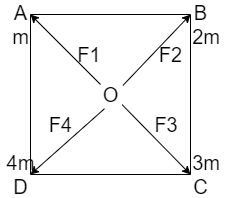Question
Question: Four particles of masses m, 2m, 3m and 4m are placed at the corners of a square of side of length ‘a...
Four particles of masses m, 2m, 3m and 4m are placed at the corners of a square of side of length ‘a’. The gravitational force on a particle of mass m placed at the centre of the square is
A) 42a2Gm2
B) 32a2Gm2
C) 22a2Gm2
D) 2a2Gm2
Solution
Recall Newton’s law of universal gravitation. According to this law, every object attracts other objects in the universe. The force of attraction points in a straight line between the centre of both the objects. It is directly proportional to the mass of the objects and inversely proportional to the square of distance between them.
Complete step by step solution:
The formula for gravitational force is given by
F=r2Gm1m2
Where G is the gravitational force
m1 is the mass of the first object
m2 is the mass of the second object
And ‘r’ is the distance between them
Given that the length of each side of the square is = a
The distance of each corner from the centre will be =2a

The gravitational force on point O due to point A is given by
⇒F1=(2a)2Gmm=a22Gm2
Similarly, the gravitational force on point O due to point B is written as
⇒F2=(2a)2G(2m)(m)=a24Gm2
The gravitational force on point O due to point C will be
⇒F3=(2a)2G(3m)(m)=a26Gm2
The gravitational force on point O due to point D will be
⇒F4=(2a)2G(4m)(m)=a28Gm2
The net force of F1and F3on point O is given by
⇒F13=F3−F1
⇒F13=a26Gm2−a22Gm2=a24Gm2
Similarly, the force of F2andF4on point O is given by
⇒F24=F4−F2
⇒F24=a28Gm2−a24Gm2=a24Gm2
The magnitude of net force on point O is given by
⇒F=(F13)2+(F24)2
⇒F=(a24Gm2)2+(a24Gm2)2
⇒F=2.a44G2m4
⇒F=22a2Gm2
Option C is the right answer.
Note: It is important to note that since the force of gravitation is directly proportional to the mass of the object, so an object with more mass will have a large force of gravitation. But it varies inversely with the square of distance, so if the distance is doubled the force of gravitation will decrease by 4 times and so on.
